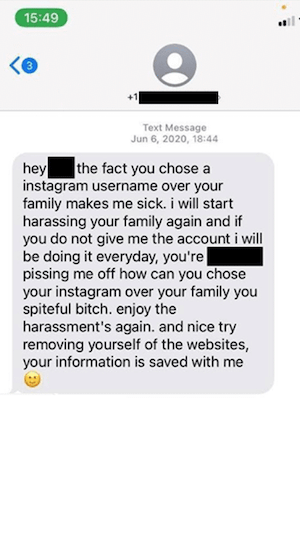 Receiving harassing text messages, often anonymous, can be a deeply unsettling experience, leading to significant stress and anxiety. Understanding what constitutes harassment, how to document and report it, and the available legal and investigative resources can empower you to handle such situations effectively. This article provides a detailed overview of dealing with harassing text messages, identifying the anonymous sender of those messages, legal implications, examples, reporting procedures, and additional support options.
Receiving harassing text messages, often anonymous, can be a deeply unsettling experience, leading to significant stress and anxiety. Understanding what constitutes harassment, how to document and report it, and the available legal and investigative resources can empower you to handle such situations effectively. This article provides a detailed overview of dealing with harassing text messages, identifying the anonymous sender of those messages, legal implications, examples, reporting procedures, and additional support options.
If you are harassed by anonymous text messages and need to prove in court or to the police who the sender is, we can help. Our cyber investigators specialize in tracing the owners of anonymous text messages, hiding behind spoofed text apps and burner phones.
Help identify an anonymous texter
What Qualifies as Harassing Text Messages
Harassment by text can occur in various forms and from different sources, including acquaintances, family members, or strangers. But often, prolonged harassment is done anonymously, complicating the issue. Identifying what constitutes harassment is the first step in addressing the issue. Harassing texts can include, but are not limited to:
- Threats of Violence: Any text that implies or directly threatens physical harm.
- Threats of Property Damage: Statements indicating an intention to damage personal property.
- Sexually Charged Messages: Texts that lead to or constitute sexual harassment.
- Anxiety-Inducing Messages: Any message that causes significant stress or fear, even if it doesn’t contain explicit threats.
It’s essential to recognize that harassment can occur even in the absence of direct threats. Repeatedly receiving spam-like, abusive, or unwanted messages that cause distress is also considered harassment.
Legal Framework and Harassment Laws
Most states in the U.S. have specific laws addressing harassment by text messaging. Understanding these laws is crucial for taking appropriate action. Contact your local authorities to learn about the specific legal framework in your state. The severity of punishment for harassing texts can vary significantly based on factors such as the nature of the harassment and any previous offenses by the perpetrator. Potential legal consequences include:
- Misdemeanors: These may result in less than a year in jail.
- Felonies: Higher-level charges that can lead to more severe penalties, especially if the harassment involves:
- Race or color
- National origin
- Gender
- Religion
- Age
- Disability
- Sexual orientation
At the federal level, laws specifically target cyber crimes, encompassing cyberstalking, interstate cyber threats and extortion, harassment or threats made through telecommunications devices, computer hacking, and identity theft. Pen America did an excellent job of listing these harassment laws, what it prohibites and the associated penalties for offenders:
18 U.S.C. § 2261A This law penalizes individuals who use interstate commerce channels to engage in behavior that causes substantial emotional distress to someone or places that person in reasonable fear of death or serious bodily harm, whether for themselves, an immediate family member, or a spouse/intimate partner.
18 U.S.C. § 875 – This law penalizes transmitting demands for ransom, extortion, threats of kidnapping or injury, or threats to harm property or reputation via interstate communication, such as email and the internet.
47 U.S.C. § 223 – This law bans transmitting obscene messages and using telecommunications devices to abuse, threaten, or harass someone across state lines, such as through telephone and email. However, if the defendant can prove they only provided access to the system or network used for the transmission, they are unlikely to be found guilty.
18 U.S.C. § 1030 – This law prohibits unauthorized access to protected computers involved in interstate commerce or communication, such as those connected to the internet, to obtain information or for purposes of extortion or threats of damage.
18 U.S.C. § 1028 – This law prohibits the unauthorized use, transfer, possession, or trafficking of another person’s identification documents or information.
Examples of Text Message Harassment

- Threats of Violence: In a Reddit thread, a victim shared that they received a text from an individual stating they have “the means to inflict severe hardship, pain, and suffering.” Such messages clearly constitute harassment and should be reported to the police immediately.
- Hate-Fueled Messages: A woman from Toronto received thousands of text messages over several months, telling her to harm herself and making sexually explicit threats. Despite the use of spoofed phone numbers, cyber investigators were able to identify the perpetrators.
These examples highlight the severity of some harassing texts and underscore the importance of taking immediate action.
Reporting Harassing Texts
When you decide to report harassing text messages, it’s crucial to be prepared and systematic. Here’s a detailed guide on how to report such incidents effectively:
- Collect Evidence:
- Save Screenshots: Capture screenshots of all harassing messages.
- Download Mobile Device Records: Access your mobile account to download call and text records. If this isn’t possible, contact your mobile provider for assistance.
- Create Backups: Ensure you have backups of all evidence in case of accidental loss.
- Report to Local Police:
- Present Your Case Clearly: Approach the police with a clear, factual account of the harassment. Avoid emotional language and name-calling and stick to the facts.
- Provide Detailed Information: Include key details such as the harasser’s name (if known), the duration of the harassment, the number of times you’ve asked them to stop, and how the harassment has escalated.
- Express Safety Concerns: Clearly articulate any fears for your safety or the safety of your family. This helps emphasize the urgency of your case.
- Follow Up with Law Enforcement:
- Speak with a Detective: Request to speak with a detective and provide them with all collected evidence.
- Request Contact Information: If no detective is available, ask for contact details and follow up diligently.
Police Involvement and Limitations
Law enforcement’s ability to handle digital harassment varies by jurisdiction. Generally, police prioritize cases that pose immediate risks to health, safety, and welfare. Here are some key considerations:
- Health: Report texts that cause severe stress or anxiety, as these can significantly impact your well-being.
- Safety: Inform the police if the texts make you feel unsafe or cause you to alter your daily routines.
- Welfare: Report messages that threaten your career, job, or livelihood, especially sexually offensive texts from colleagues.
If the police decide to investigate, they may need to obtain telephone records from mobile providers. This process requires legal permissions and can take time, so be prepared for potential delays.
What Can the Police Do About Harassing Text Messages?
Police responses to harassing text messages can vary, but in most cases, the best option is to request phone records from the phone carrier to trace the source of the harassing texts. This requires legal permission and can be a time-consuming process.
Most people who come to us have been to the police, but they have been unable or unwilling to assist. If the police determine that intervention is necessary, they can request the necessary records and pursue the investigation. However, many local police departments may lack the resources or expertise to handle digital harassment cases effectively.
Cyber Investigation Services
When local police are unable to help, cyber investigation services can be a valuable alternative. These services specialize in tracing anonymous text apps and spoofed phone numbers. Cyber investigators can identify the individuals behind the harassment and provide you with the evidence needed to take legal action.
- Anonymous Text Apps: Texting apps like TextFree and TextNow offer users anonymity, but they can be traced by our skilled investigators.
- Tracing Spoofed Numbers: our cyber investigators can trace spoofed phone numbers and identify the individuals responsible for the harassment.
Help identify an anonymous texter
Conclusion
Dealing with harassment by text requires a thorough understanding of your rights and the appropriate steps to take. By collecting and documenting evidence, reporting to local law enforcement, and considering alternative solutions like cyber investigation services, you can effectively address and mitigate the impact of harassing text messages. Empower yourself with knowledge and take decisive action to protect your well-being and safety.
And remember, nobody is anonymous on the internet. Text senders can be identified, even through spoofing apps and fake phone numbers.

